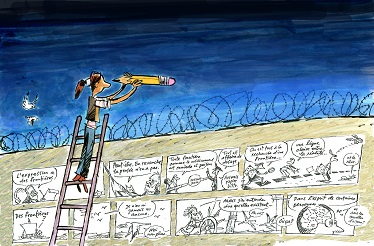La mise en page aux frontières du lisible en France dans les années 70
DOI:
https://doi.org/10.15167/1824-7482/pbfrm2024.2.2540Keywords:
Aesthetics, Sixties, reading, panel, gutterAbstract
From the 1960s onwards, a generation of French authors began experimenting with page layout in ways that departed from its traditional use. Our aim here is to look at the creative processes that lead to a gradual breakdown in the narrative transitivity provided by the page layout, among other things. These may take the form of an increase in the number of boxes on the page or, on the contrary, their disappearance in table compositions; the movement of the eye around the page may also be hindered by unusual paths that may go so far as to contradict the temporality inherent in the distribution of the action into distinct units; Finally, the squares can become porous and the images flow into each other through gaps that destabilise the structuring of the sequence. These various transgressions of the narrative of the page layout lead the comic strips towards pictorial regimes that invest more in the spatiality of the device than in the temporality of its discontinuity and thus offer original and striking aesthetic experiences.
References
ANDRIEU DE LEVIS J-C., De la ligne claire à la ligne « pas claire » : Émancipations esthétiques de la bande dessinée en France et aux États-Unis à l’orée des années 70, thèse de doctorat, Paris IV Sorbonne, 2019.
BAETENS J. et VAN GELDER H., « Permanences de la ligne claire. Pour une esthétique des trois unités dans L’ascension du Haut-Mal de David B. », in FRESNAULT-DERUELLE P. et SAMSON J. (dir.), Poétiques de la bande dessinée, L’Harmattan, 2007, pp. 183-194.
BAETENS J., Hergé, écrivain, Flammarion, 2006.
BOYER L., Les images libres : dessiner pour l'enfant entre 1966 et 1986, Memo, 2022.
CHAVANNE R., Composition de la bande dessinée, PLG, 2010.
FRÉMION Y., Les Nouveaux petits-miquets, Le citron hallucinogène, 1982.
GOMBRICH E. et ERIBON D., Ce que l’image nous dit, entretiens sur l’art et la science, Cartouche, 2009.
LOB J. et PICHARD G., Ulysse, Dargaud, 1974.
LYOTARD J-F., Discours, Figure, Klincksieck, 1974.
MARION P., Traces en case, Travail graphique, figuration narrative et participation du lecteur, Louvain-la-Neuve, Academia, 1993.
MC CLOUD S., L’art invisible : comprendre la bande dessinée, traduit par Dominique Petitfaux, Delcourt, 2008.
ORY P., « Mickey Go Home! La désaméricanisation de la bande dessinée (1945-1950) », Vingtième Siècle, Revue d’histoire, 4, 1984, pp. 77–88.
PEETERS B., « Le moment belge », in ORY P., MARTIN L., VENAYRE S., MERCIER JP (dir.), L’Art de la bande dessinée, Citadelle et Mazenod, 2012, pp. 199-257.
PEETERS B., Lire la bande dessinée, Flammarion, 2010.
ROBERT P., La Bande dessinée, une intelligence subversive, Presses de l’Enssib, 2018.
STERCKX P., Sexties, Crepax, Cuvelier, Forest, Peellaert, Bureau des Grands Évènements (BGE), 2009.
WOLINSKI G. et PICHARD G., Paulette, éditions du Square, 1971.
WOOD G., Art Nouveau & Erotisme, Herscher, 2000.
Published
Issue
Section
License
Copyright (c) 2025 Jean-Charles Andrieu de Lévis

This work is licensed under a Creative Commons Attribution-NonCommercial 4.0 International License.


